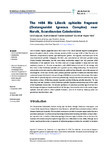The >494 Ma Lillevik ophiolite fragment (Gratangseidet Igneous Complex) near Narvik, Scandinavian Caledonides
| dc.contributor.author | Slagstad, T | |
| dc.contributor.author | Anderson, Mark | |
| dc.contributor.author | Saalmann, K | |
| dc.contributor.author | Hagen-Peter, G | |
| dc.date.accessioned | 2021-04-20T15:38:24Z | |
| dc.date.available | 2021-04-20T15:38:24Z | |
| dc.date.issued | 2021-01-05 | |
| dc.identifier.issn | 2387-5844 | |
| dc.identifier.issn | 2387-5852 | |
| dc.identifier.uri | http://hdl.handle.net/10026.1/17056 | |
| dc.description | No embargo required. | |
| dc.description.abstract |
One of several irregular, plagioclase-phyric felsic veins in the Lillevik ophiolite fragment (Gratangseidet Igneous Complex) in Narvik, northern Norway, yielded a U–Pb zircon age of 494 ± 5 Ma. The veins cut deformed, compositionally layered, light REE-depleted gabbros that arguably constituted part of the now-dismembered ophiolite stratigraphy. The felsic veins were themselves deformed, probably during Silurian Scandian deformation, but the cross-cutting relationships suggest that they post-date initial deformation of the ophiolitic rocks. The felsic veins are strongly depleted in heavy REE and have moderately juvenile Lu–Hf zircon compositions, with εHf494 between 6.2 and 9.9. By analogy with felsic rocks in other Caledonian ophiolites and supported by cross-cutting relationships, the chemical and isotopic data can be interpreted to reflect formation by partial melting of basaltic rocks in the presence of residual garnet. In this case, the felsic veins probably post-date ophiolite formation and obduction onto a continental margin. We therefore interpret the age of 494 Ma to represent the minimum age of formation of the Lillevik ophiolite fragment. Previously published age, isotopic and chemical data from the region document an at least 20 Myr-long complex magmatic evolution following ophiolite obduction. The new data show that Late Cambrian to Early Ordovician ophiolite fragments extend along most of the length of the Scandinavian Caledonides. The tectonic significance of a previously published age of 474 Ma from the Gratangseidet Igneous Complex and 481 to 469 Ma ages from a tonalite sheet in the nearby Lyngen ophiolite, both interpreted to reflect ophiolite formation, needs to be tested by obtaining whole-rock geochemical data from these units. | |
| dc.language.iso | en | |
| dc.publisher | Geological Society of Norway | |
| dc.title | The >494 Ma Lillevik ophiolite fragment (Gratangseidet Igneous Complex) near Narvik, Scandinavian Caledonides | |
| dc.type | journal-article | |
| dc.type | Journal Article | |
| plymouth.volume | 100 | |
| plymouth.publication-status | Published online | |
| plymouth.journal | Norwegian Journal of Geology | |
| dc.identifier.doi | 10.17850/njg100-4-5 | |
| plymouth.organisational-group | /Plymouth | |
| plymouth.organisational-group | /Plymouth/Faculty of Science and Engineering | |
| plymouth.organisational-group | /Plymouth/Faculty of Science and Engineering/School of Geography, Earth and Environmental Sciences | |
| plymouth.organisational-group | /Plymouth/REF 2021 Researchers by UoA | |
| plymouth.organisational-group | /Plymouth/REF 2021 Researchers by UoA/UoA07 Earth Systems and Environmental Sciences | |
| plymouth.organisational-group | /Plymouth/Users by role | |
| plymouth.organisational-group | /Plymouth/Users by role/Academics | |
| dcterms.dateAccepted | 2020-12-22 | |
| dc.rights.embargodate | 2021-4-22 | |
| dc.identifier.eissn | 2387-5852 | |
| dc.rights.embargoperiod | Not known | |
| rioxxterms.versionofrecord | 10.17850/njg100-4-5 | |
| rioxxterms.licenseref.uri | http://www.rioxx.net/licenses/all-rights-reserved | |
| rioxxterms.licenseref.startdate | 2021-01-05 | |
| rioxxterms.type | Journal Article/Review |


